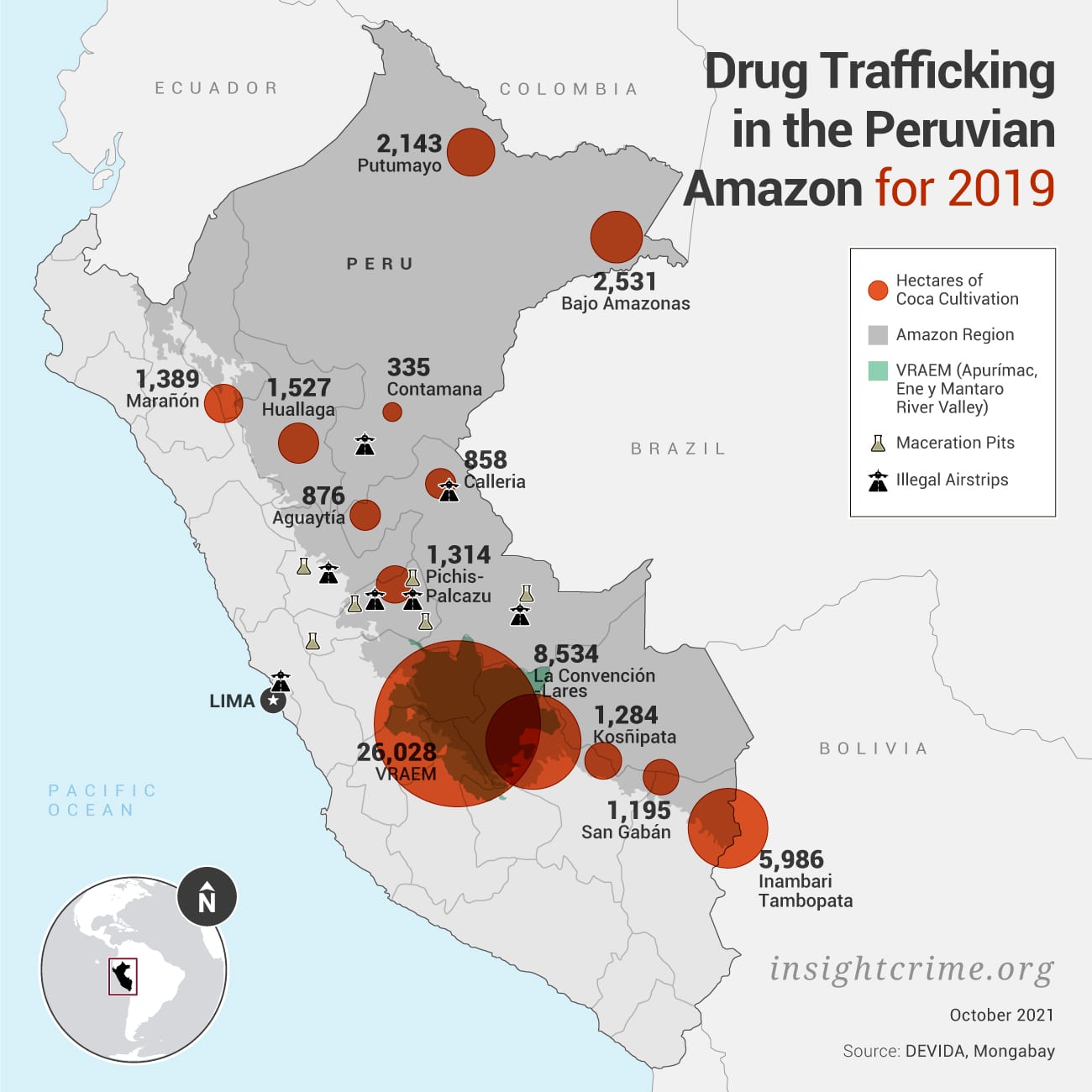Though the exact amount of coca in Peru has been the subject of recent debate, reports indicate that coca crops have increased and are spreading.
Coca cultivation rose 22 percent to 88,200 hectares in 2020, according to the White House Office of National Drug Control Policy (ONDCP). Peru’s national anti-drug agency has refuted the figure, claiming in a statement that the report contained a “series of errors.” The agency has yet to publish its own report for 2020.
The White House and Peru have disagreed in the past on coca crop estimates. In 2019, the ONDCP reported 72,000 hectares in Peru, while Devida reported 54,655 hectares.
It’s not unheard of to have differences in coca crop estimates due to methodologies or technology. Devida says it uses methods established by the United Nations Office on Drugs and Crime (UNODC) that had been applied until the organization’s departure from Peru in 2018. Variations in coca crop estimates have also been seen in Colombia, the top cocaine-producing country in the region.
Several sources who spoke to InSight Crime agreed that what’s undeniable is that the amount of coca in Peru is increasing. Here are three reasons for the surge.
1. Eradication Halted Due to COVID-19
In 2020, the government suspended eradication efforts during the coronavirus pandemic, redirecting policing and economic resources elsewhere. Much of Devida’s activities were paralyzed.
“The fight against drugs was neglected during the pandemic. We are seeing the explosive growth of illegal coca crops as a result of the government’s neglect during the health crisis,” Rubén Vargas, Peru’s former Minister of the Interior, told InSight Crime.
The National Police, which is involved in coca eradication, enforced lockdowns and restricted travel. In addition, the force itself was decimated by COVID-19. More than 50,000 police officers contracted the virus, and more than 700 died from it.
The pandemic resulted in coca eradication efforts being sidelined, and institutional capacity compromised.
2. Balloon Effect: Crops Move into Other Territories
When coca crops are destroyed in one region, traffickers routinely seek to plant crops in other territories.
The clearest example of crop relocation has occurred in the northern department of San Martin. In the early 2000s, the region was dubbed an eradication success, which occurred in tandem with alternative development projects.
The Peruvian government promoted “El Milagro de San Martin” as a replicable model. Coca, however, soon came to cover the Valley of the Apurímac, Ene and Mantaro Rivers (Valle de los Ríos Apurímac, Ene y Mantaro – VRAEM).
The VRAEM has since become Peru’s most important area for coca production, with between 55 and 70 percent of the country’s total crops concentrated there. Eradication campaigns in this region have been unsuccessful and made nearly impossible by the jungle terrain and lack of security. Armed groups aligned with drug clans and the remnants of Shining Path guerrillas have long had a presence in the region.
Farmers have also moved their plantations again to other regions. Several sources interviewed by InSight Crime agreed that more crops are being grown in regions bordering Brazil, Colombia and Bolivia.


3. People Head Home to the Countryside
Economic hardship from COVID-19 may also be spurring coca production.
Coca Crops Surge Amid Security Vacuum on Peru-Bolivia Border
Carlos Basombrio, another former Minister of the Interior, said the pandemic forced many people living in urban areas to move to the countryside. In 2020, more than 200,000 people returned to their places of origin in rural districts, according to a book he recently published on Peru’s criminal economies. Once there, sowing coca or working on plantations may have provided one of the few viable economic opportunities.
In the past, Peru has seen people take up coca farming as a means of sustenance. For example, when coffee prices have dipped, farmers abandoned crops to work on coca plantations.
General Raúl Del Castillo, the director of Peru’s anti-narcotics police, told InSight Crime that people were already in economic crisis when the second wave of the virus arrived.
“Many people that were not involved in drug trafficking, but who needed help, entered into illegality in order to survive,” he said.

